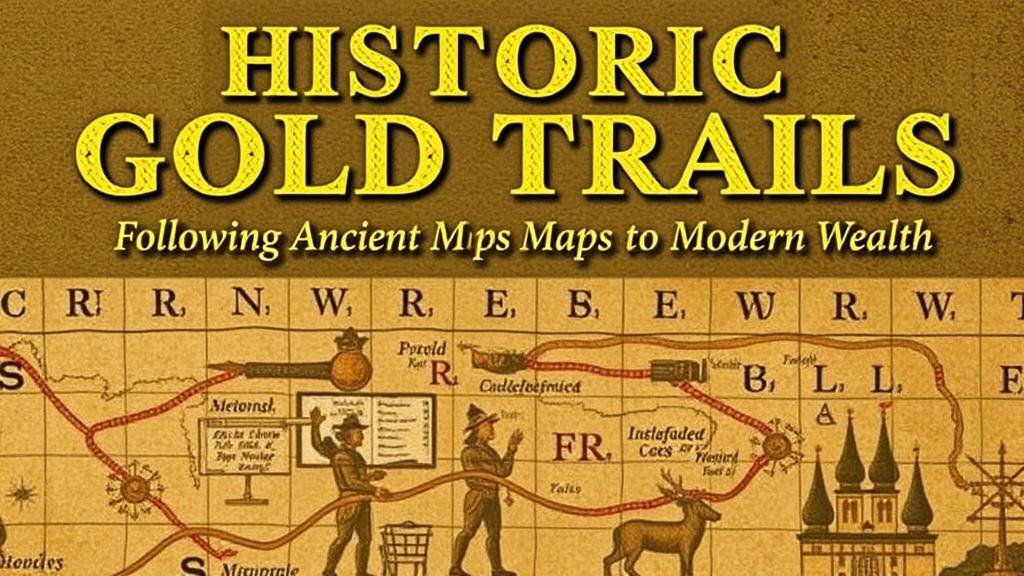Historic Gold Trails: Following Ancient Maps to Modern Wealth
Historic Gold Trails: Following Ancient Maps to Modern Wealth
For rockhounds and mineral collectors, the pursuit of gold is more than just a hobby; it’s an adventure through history. Many ancient trails–traced by prospectors and miners–lead to rich deposits waiting to be rediscovered. This article delves into the historic gold trails, the maps that guide them, and how modern collectors can stake their claims in the pursuit of prosperity.
Understanding the Historic Gold Trails
Gold trails are pathways carved out during the gold rush era of the 19th century, notably in regions such as California, Colorado, and Alaska. e routes were not only vital for the transportation of miners but also served as guides to rich mineral deposits. For example, the California Gold Rush (1848-1855) attracted over 300,000 fortune seekers, significantly impacting the economy and demographics of the West.
Key trails involved in historic gold collection include:
- The South Fork American River Trail
- The Valdez-Fairbanks Trail in Alaska
- The Denver & Rio Grande Western Railroad routes
The Role of Ancient Maps
Maps from the gold rush era provide valuable insights into where minerals are likely found. These maps often indicate old mining districts, supply routes, and locations where gold was previously discovered. Collectors can harness this information to focus their search on propriety lands. Notably, the Thomas Hart Benton map from 1864 highlights vital mining towns and routes that can still serve as a guide today.
It’s important to remember that many mining sites are now private properties or protected lands. Always check local laws and obtain necessary permissions before prospecting.
Modern Techniques for Prospecting
Today’s mineral collectors have access to advanced technology and tools that allow them to find gold where ancient miners left off. Here are some techniques that blend historical knowledge with modern equipment:
- Metal Detectors: Devices like the Minelab Equinox 800 can detect gold nuggets and caches hidden beneath the surface.
- Geochemical Analysis: Modern tools like portable X-ray fluorescence (pXRF) analyzers can assess the mineral composition of soil samples, identifying gold content.
- GPS Technology: Using GPS devices or applications helps collectors navigate to historical mining sites identified on ancient maps.
Statistics: The Gold Still Out There
Statistics show that gold is still being discovered every year, with approximately 2,500 tons mined globally in 2021 alone, according to the U.S. Geological Survey. Less than 10% of potential gold-containing areas have been thoroughly explored. This means that significant amounts of gold are still hidden beneath the earth, awaiting the keen eye of a dedicated collector.
Practical Tips for Modern Collectors
Here are some actionable tips for rockhounds and mineral collectors looking to follow historic gold trails:
- Research the History: Dive into historical records and find maps that detail previous discoveries. Libraries and local historical societies can be invaluable resources.
- Join Local Clubs: Engaging with local rockhounding clubs can connect you with experienced prospectors who possess knowledge about the area.
- Practice Responsible Prospecting: Always fill your holes, respect wildlife, and adhere to regulations regarding collecting to ensure minimal environmental impact.
Potential Concerns
While the allure of gold can be enticing, prospective collectors should also be aware of the challenges and potential pitfalls. Legal issues related to land ownership can arise, and some trails may contain hazards, such as unstable ground or harsh weather conditions. Always prioritize safety and stay informed about local mining laws.
Conclusion: The Path to Modern Wealth
The journey along historic gold trails has the potential to yield not only wealth but also a deepened appreciation for the history and geology of the land. By following ancient maps, utilizing modern technology, and adhering to best practices, today’s collectors are uniquely positioned to uncover hidden treasures while honoring the legacy of those who walked the trails before them.
Whether you are an experienced prospector or a novice rockhound, the adventure awaits just a map away.



